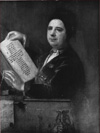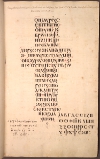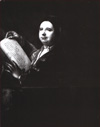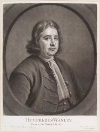- Antiquaries
- Sir Robert Cotton
- Sir William Dugdale
- George Hickes
- Humfrey Wanley
- Thomas Tanner
- Benjamin Thorpe
- Joseph Bosworth
- John Mitchell Kemble
- John Earle
- W. G. Searle
- Walter de Gray Birch
- W. H. Stevenson
- G. B. Grundy
- Hector Munro Chadwick
- Sir Frank Stenton
- Mary Prescott Parsons
- Florence Harmer
- Agnes Jane Robertson
- Dorothy Whitelock
- Richard Drögereit
- Pierre Chaplais
- Nicholas Brooks
- Patrick Wormald
Humfrey Wanley
 Humfrey Wanley (1672-1726) is renowed above all for his catalogue of manuscripts containing texts in Old English, published in 1705; but he also deserves recognition as one who attempted to do for England what Mabillon had done, for the continent, in De Re Diplomatica (1681), and who first appreciated the value of single-sheet charters as dated specimens of Anglo-Saxon script.
Humfrey Wanley (1672-1726) is renowed above all for his catalogue of manuscripts containing texts in Old English, published in 1705; but he also deserves recognition as one who attempted to do for England what Mabillon had done, for the continent, in De Re Diplomatica (1681), and who first appreciated the value of single-sheet charters as dated specimens of Anglo-Saxon script.
Wanley's 'Book of Specimens'
Wanley had developed a strong interest in ancient script and language as a young man, and in 1695 abandoned his job as a draper's apprentice in Coventry and moved to Oxford. He established himself at University College, and soon became an Assistant at the Bodleian Library. In 1697-9 Wanley made a series of facsimiles of the script and decoration of ancient manuscripts, in what became known as his 'Book of Specimens' (Longleat House MS. 345); and it was on the strength of this book that he acquired the reputation which gained him preferment elsewhere.
In 1697, when first in need of dated specimens of script for the purposes of his 'Book of Specimens', Wanley had the audacity to ask Thomas Smith (Cottonian Librarian) if he could borrow the great portfolio of Anglo-Saxon charters from the Cotton Linrary. Smith responded: 'As to what concernes the other part of your letter, I must take leave to write freely to you, that I am extremely amazed at your request of having the book of the Charters of the Saxon Kings (which I know not whether I did well to call all of them original, some of which I know and can prove to bee forged) sent down to Oxon, upon a more than single accompt. Truly if the mountaine cannot come to Mahomet, Mahomet must condescend and bee content to go to the mountaine. I beeleive, that that curious and invaluable booke was never lent out of the house since the collection was first made, no not to Mr Selden, nor to Sir William Dugdale, tho' they had the free use of the Library as much as if it had been their owne: and for my own part I was forced to use it there, and to go downe to Westminster, tho' indisposed, and in all weathers, when I made that hasty and imperfect extract of it, without so much as presuming to bee favoured with the use of it at my lodging, which would have been at that time a great ease and advantage to mee.' (Smith to Wanley, 8 June 1697.)
Wanley and the Somers charters
Wanley's main contribution to charter scholarship is not well known: his description, made in 1701-2, of the important group of 24 charters from the Worcester archive which belonged in his day to John, Lord Somers (1651-1716), published in Librorum Vett. Septentrionalium, qui in Angliæ Biblioth. extant, Catalogus Historico-Criticus [Antiquæ Literaturae Septentrionalis Libri Duo, vol. II] (1705), pp. 301-3. The charters are said to have been kept in 'a very little Oval Deal Box'. After the death of Lord Somers in 1716, Wanley tried hard to get his hands on them, but alas his efforts were in vain. The charters were seen by George Smith, and were printed by him in Historiæ Ecclesiasticae Gentis Anglorum Libri Quinque, Auctore Sancto & Venerabili Baeda, ed. J. Smith (Cambridge, 1722), pp. 764-82. They have since vanished without trace. Any notes about or transcriptions of these charters might well prove to be of considerable interest.
Wanley and the Harley library
Wanley moved to London in 1700; and, though employed for the time being as secretary of the S.P.C.K., he soon began to prosper under the patronage of the statesman Robert Harley (1661-1724), then Speaker of the House of Commons. Wanley was one of three scholars appointed to report on the condition of the Cottonian library in 1703; he was advising Harley on the purchase of manuscripts (notably the library of Sir Symonds D'Ewes) in the same year; and sooner or later he set to work on an ambitious catalogue of the Harleian manuscripts (his 'Catalogus Maior', now BL Add. 45699-700). Wanley is chiefly renowned for his catalogue of 'ancient northern books', begun while he was based in Oxford and published in 1705; it retains its value not least for its detailed descriptions of Cottonian manuscripts lost or damaged in the fire of 1731, and is the forerunner of Neil Ker's Catalogue of Manuscripts Containing Anglo-Saxon (1957). In 1708 Wanley took office as full-time librarian to Robert Harley, and at once began his work on what would later become the first published catalogue of the Harleian library ('Catalogus Brevior', now BL Add. 45701-7). Harley was created 1st Earl of Oxford in 1711, and died in 1724. Responsibility for the library seems to have passed in 1714 to Robert's son Edward (1689-1741), 2nd Earl of Oxford, of Wimpole Hall, Cambridgeshire.
Wanley's papers
Miscellaneous papers and notes by Wanley, including many of considerable interest to modern Anglo-Saxonists, abound among the Harleian manuscripts in the British Library (e.g. BL Harley 7055). His 'Memorandum Book' (BL Lansdowne 677) is ptd in Diary, ed. Wright and Wright, II, 427-37; his diary (BL Lansdowne 771), covering the period 1715-26, affords a view of his day-to-day activities as librarian; and his letters to other scholars (collected and edited by Heyworth) give full vent to his character, powers, and scholarly aspirations. Six volumes of letters to Wanley on antiquarian and other matters, full of incidental interest, are in BL Harley 3777-82; further volumes of his notes and correspondence, formerly preserved among the Portland papers at Welbeck Abbey, are now readily accessible in the British Library (Add. 70469-92).
Wanley died on 6 July 1726, and is buried in the parish church of St Marylebone, London.
Bibliography
R. Nares, et al., A Catalogue of the Harleian Collection of Manuscripts in the British Museum, 4 vols. (London, 1808-12) III, for description of Wanley's correspondence in BL Harley 3777-82, and other papers;
C. E. Wright, 'Humfrey Wanley: Saxonist and Library-Keeper', Proceedings of the British Academy 46 (1961), 99-129; The Diary of Humfrey Wanley 1715-1726, ed. C. E. Wright and R. C. Wright, 2 vols. (London, 1966); C. E. Wright, Fontes Harleiani (London, 1972);
Letters of Humfrey Wanley: Palaeographer, Anglo-Saxonist, Librarian 1672-1726, ed. P. L. Heyworth (Oxford, 1989);
M. McC. Gatch, 'Fragmenta Manuscripta and Varia at Missouri and Cambridge', TCBS 9 (1986-90), 434-75, at 439-44;
S. Keynes, 'The Reconstruction of a Burnt Cottonian Manuscript: the Case of Cotton MS. Otho A. I', Brit. Lib. Jnl 22 (1996), 113-60, at 126-35 (Wanley's 'Book of Specimens'); S. Keynes, 'Wanley, Humfrey', The Blackwell Encyclopaedia of Anglo-Saxon England, ed. M. Lapidge, et al. (Oxford, 1999), pp. 466-7 (above).
An iconography of Humfrey Wanley
An enamel miniature, by an unknown artist, is at Welbeck abbey. Goulding, Welbeck Abbey Miniatures, pp. 166-7 (no. 252): 'Head and shoulders to sinister, with gaze directed to spectator, clean shaven, yellow cloak.'
For Thomas Hill, see R. W. Goulding, The Welbeck Abbey Miniatures Belonging to His Grace The Duke of Portland K.G., G.C.V.O.: a Catalogue Raisonné, Walpole Society 4 (1916 for 1914-15), pp. 166-7; R. W. Goulding (rev. C. K. Adams), Catalogue of the Pictures Belonging to His Grace The Duke of Portland, K.G., at Welbeck Abbey, 17 Hill Street, London, and Langwell House (Cambridge, 1936), pp. 449-50; David Piper, Catalogue of the Seventeenth-Century Portraits in the National Portrait Gallery 1625-1714 (Cambridge, 1963), p. 372.








